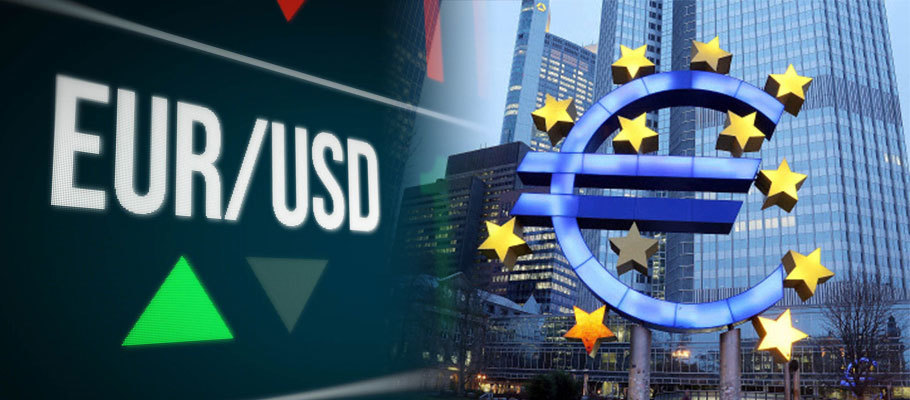
Published: June 8th, 2022
EUR/USD at mid-week is trying to climb out of a trough touching five-year lows, but may need intervention from the European Central Bank (ECB) to beat an already hawkish market and sustain its recovery momentum before new US inflation data is released.
The single currency stayed above a handle of 1.06 against the greenback through much of last week and into Tuesday, gaining substantial support from a hawkish market that’s re-pricing its expectations for ECB interest rate action in advance of the central bank’s June policy meeting.
The meeting set for this Friday is widely expected to announce the end of Frankfurt’s last and longest running quantitative easing (QE) programme, while providing insights into the likely future path of European interest rates.
However, forex traders will be focused on anything that signals the ECB’s likely policy direction in July and September, particularly any guidance about the lift Eurozone interest rates could get in July.
In a note to investors, Barclays European Economics Unit said that EUR/USD could rise this week ‘thanks to a more hawkish European Central Bank coming out of Friday’s meeting and a weaker Dollar. In that scenario we believe upside resistance at 1.0789 will be tested.
‘We will be closely monitoring post–meeting communications from the Friday meeting for indications that the tightening cycle is going to become more aggressive. There is even a small possibility that the ECB decides to raise rates this week.’
The Euro could also move on clues about the coming pace and scale of any added steps by the bank, since a recent shift in pricing has left some traders asking if the ECB’s deposit rate might rise by 0.35 per cent next month, for a total rise of 1.25 per cent for the year to date.
That would see the deposit rate rise to well above zero, marking an end to the extended period of negative interest rates, where commercial banks have effectively paid a price for using the ECB as a safe haven for their cash. Bringing that era to an end would be a turning point for the Euro to Dollar rate outlook.
ECB Governing Council members have been publicly debating whether or not to raise the benchmark in a standard 0.25 per cent step or by a larger 0.50 per cent increment in July, following the expected end of the ECB’s final QE programme this week.
FX Analysts at CIBC Capital Markets said in a Monday briefing that ‘inflation is three per cent higher now than it was before the last forecast update. As a result, (ECB Chair Christine) Lagarde may consider a more aggressive response than standard 25bps increases.'
'If that occurs it could add support to EUR’s climb back against the Dollar and Pound.’
Friday’s decision from Frankfurt will follow Eurostat figures that show the Eurozone inflation rate climbing to a new record of 8.1 per cent, significantly closing the gap between price growth levels in the Eurozone and those in America, where annual inflation last month was 8.2 per cent.
EUR started 2022 on sturdy political tailwinds out of Italy, when markets reacted warmly to the appointment of neoliberal technocrat Mario Draghi as Italian Prime Minister.
After President Sergio Mattarella was re-elected in January, analysts thought the election result would establish policy continuity and enable Draghi to move ahead with EU-mandated policy changes required to obtain EUR 200 billion in EU funding.
Analysts at the time said Mattarella’s return to power was positive news for markets and a euro rally off the back of the news got underway. The EUR/USD rate also rose from a multi-month low seen the previous week.
It was clear however that chart trends were still favouring USD in the short term, with the future outlook depending then, as now, on announcements from the next ECB policy meeting.
Frankfurt avoided making major changes to interest rate policy at its February meeting, but did flag its concerns about early indicators of rising inflation, both in the Eurozone and globally.
Consensus at the time looked for ECB bankers to raise rates by the end of this year, with the Euro outlook driven by whether or not Frankfurt policymakers met that expectation.
A market analysis of Euribor prices suggested that investors were moving their expectations for the timing of an ECB rate rise forward, with December 2022 seen as the most likely date. This was, of course, all before the conflict in Ukraine and its knock-on effects to energy and food prices.
At the time, Frankfurt kept its dovish approach on expectations that inflation would fade by mid-year and that any risk of inflation staying above the bank’s two per cent target was small.
Some analysts did note that even if the ECB stayed the course on rates, EUR/USD exchange rate could continue to rise.
That's because the Greenback started 2022 on the back foot, shrugging off strong buying interest that followed the Fed's December 2021 policy update. That slump would give EUR/USD upside momentum if sustained.
Reuters said EUR/USD would likely keep rising while analysts at Barclays currency strategy unit also believed the dollar could face headwinds
In an interview with Bloomberg, they said conditions pointed to short positions on the Greenback as a ‘tactical entry point’ since the market might now be ready to sell USD after a brief uptick in buying seen the previous week.
Forex markets, they said, have a tendency to revert on trends seen in January, suggesting that any USD strength would start to unwind as the month and quarter progressed In January 2022, the Dollar appreciated by close to two per cent against the Euro.